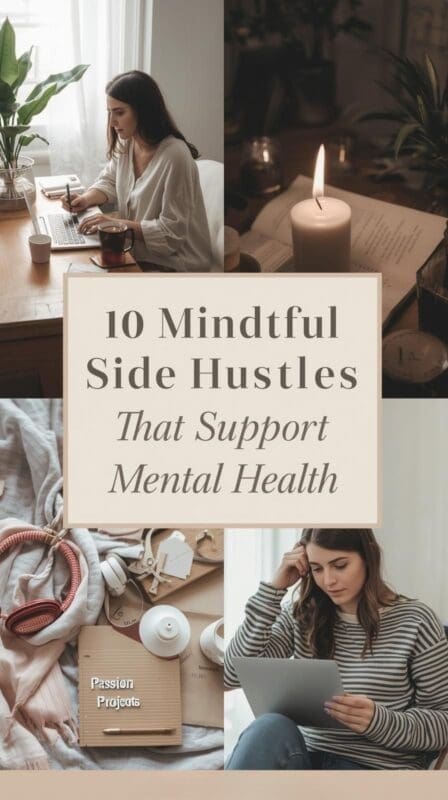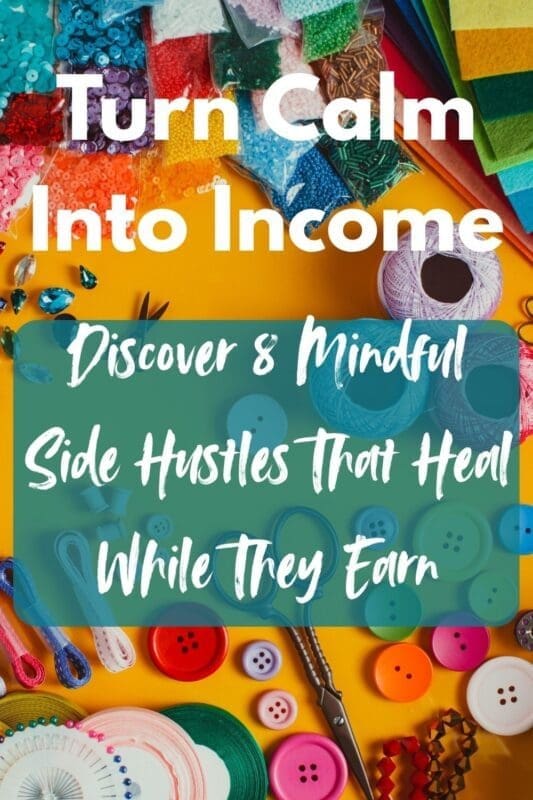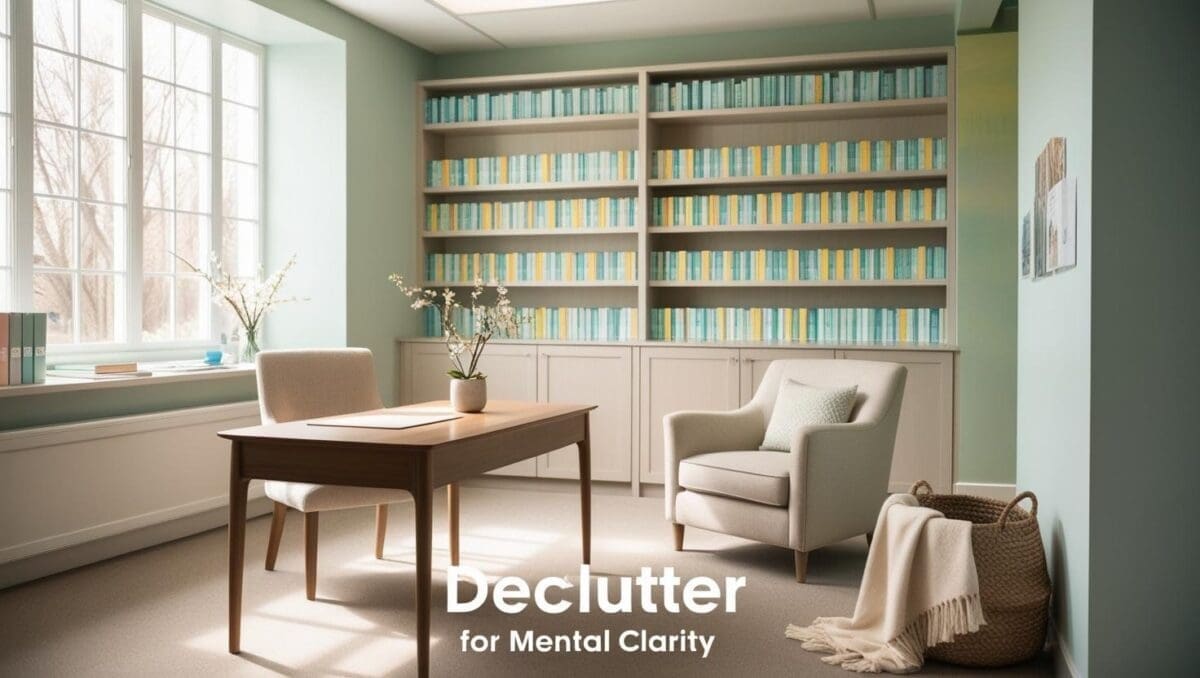Money and mental health often feel like opposing forces — the more we chase, the more overwhelmed we become.
But what if your side hustle could restore you instead of draining you?
Mindful side hustles are small, creative ventures that bring both income and inner calm. They allow you to slow down, express yourself, and reconnect with meaning — all while earning a little extra.
Let’s explore how these gentle business ideas can nurture your emotional wellness, regulate your nervous system, and create sustainable joy in your everyday life.
Why Mindful Side Hustles Support Emotional Wellness
Unlike high-pressure business models, mindful side hustles are intentionally slow and sensory. They engage your body and mind together — activating the parasympathetic nervous system, the body’s natural rest-and-restore mode.
They help you:
- Enter a creative flow state that reduces anxiety and perfectionism.
- Experience mastery and autonomy, boosting dopamine and confidence.
- Build self-worth through gentle productivity and small wins.
- Reconnect with sensory and nature-based grounding, improving focus and emotion regulation.
When your income stream supports your inner peace, your business becomes an act of self-care — not stress.
🪶 1. Crafting Calming Tools
Crafting calming tools — like worry stones, fidget tools, affirmation jars, or sensory kits — is more than a hobby; it’s a nervous system reset in disguise.
The repetitive, tactile act of working with clay or wood gently quiets the stress response. Each motion signals safety to your brain, activating vagus nerve relaxation — a core process in emotional regulation. These small, meaningful creations can be sold through Etsy or local wellness markets as handmade self-care gifts or mindfulness aids.
Example:
Molding a set of smooth, palm-sized “breathe stones” in soft earth tones. Each one carries an intention — calm, courage, gratitude. The process becomes meditation, and the final product becomes a comforting keepsake for someone else’s anxiety.
Mental health benefit:
Repetition and texture engage sensory pathways, grounding the body and lowering cortisol. Creative work like this helps anxious thoughts slow down, fostering a sense of safety and flow.
✍️ 2. Writing & Journaling Projects
Writing has long been one of the most effective and accessible tools for emotional regulation. Turning it into a side hustle — whether through blogging, gratitude journals, guided printables, or digital eBooks — transforms healing into purpose.
The act of writing helps organize thoughts and separate emotion from identity. It builds clarity, resilience, and perspective. Selling reflective digital journals on Etsy or through your blog can generate passive income while helping others manage stress and anxiety.
Example:
Designing a printable “Evening Calm Journal” with prompts like “What brought me peace today?” and “What can I release before bed?” — a beautiful blend of mindfulness and creativity.
Mental health benefit:
Expressive writing activates the left prefrontal cortex (logic and language), helping regulate emotional intensity and reduce rumination.
💻 3. Digital Products That Inspire Calm
Digital side hustles are ideal for creative introverts who crave quiet productivity. Designing affirmation cards, mental health trackers, or Canva templates gives you the satisfaction of creation without time-based pressure.
Creating digital wellness tools also reinforces your own healthy habits. Every affirmation you design, every printable you craft, subtly retrains your brain toward calm.
Example:
Design a digital “Calm Planner” in muted tones with breathing reminders and gentle affirmations. Once created, it becomes a passive income stream you can sell repeatedly.
Mental health benefit:
Visual design with calming colors and soft symmetry supports emotional regulation and visual serenity, which subconsciously lowers stress.
🌿 4. Nature-Based Side Hustles
Nature heals — and it also inspires. Creating small businesses that revolve around plants, herbs, or natural aesthetics can regulate both your body and your workflow.
Tending to greenery activates parasympathetic regulation, lowering heart rate and improving focus. From herbal bundles and dried flower art to propagated houseplants or botanical photography prints, these nature-rooted crafts attract eco-conscious buyers seeking calm.
Example:
Gather eucalyptus and lavender to make “Relax & Restore” bundles. Wrap them in linen and twine for a grounding, minimalist look — a perfect addition to wellness stores or therapist offices.
Mental health benefit:
Natural textures and scents stimulate sensory grounding, helping to decrease anxiety and restore focus.
🕯️ 5. Candle & Scent-Making
Scent connects directly to the limbic system — the brain’s emotional core. Creating essential oil candles, wax melts, or aromatherapy sprays lets you merge creativity with neuroscience.
Lighting a candle becomes a sensory ritual of release. As the scent fills the air, your vagus nerve signals safety, heart rate slows, and muscles relax.
Candle-making can become both your stress-relief practice and your most profitable product line.
Example:
Craft a candle called “Stillness” — lavender, bergamot, and sandalwood — packaged with a small affirmation card: “Let this flame remind you to rest.”
Mental health benefit:
Combining sensory stimulation (sight, scent, warmth) supports emotional regulation and reinforces healthy daily rituals.
🎨 6. Emotional Art & Decor
Turning your emotional journey into art prints, affirmation posters, or mood-based illustrations can transform self-expression into meaningful business. Art gives emotions form — a way to release, process, and connect.
Creating visual reminders of peace helps others too. You can sell calming wall art or printable affirmations that promote emotional balance and inner strength.
Example:
Design an art print titled “Soft Strength” with warm pastel gradients and a short affirmation like “You are allowed to rest.” Sell it as both a digital download and printed poster.
Mental health benefit:
Art-making increases dopamine, improves mood, and supports self-acceptance — turning creativity into therapy.
🪔 7. Teaching or Coaching with Heart
If connection brings you joy, consider turning your empathy into a service-based mindful side hustle.
Offering creative workshops, mindfulness classes, or emotional-growth coaching lets you share peace and create meaningful relationships.
Teaching self-care practices activates a sense of purpose and belonging, which research links to increased serotonin and reduced depressive symptoms.
Example:
Host a “Creative Calm Workshop” where participants make their own sensory tools — pairing mindfulness education with art therapy-inspired activities.
Mental health benefit:
Altruism and connection strengthen neural pathways for reward and empathy, creating long-term happiness.
☕ 8. The Power of Slow Entrepreneurship
The secret to sustainable success isn’t doing more — it’s doing meaningfully.
Slow entrepreneurship is about crafting a business rhythm that mirrors your nervous system’s needs.
Treat your side hustle as a mindfulness practice:
- Work in focused, flow-based blocks.
- Rest intentionally.
- Choose aesthetics that soothe rather than stimulate.
When you center calm in your business model, you’ll attract like-minded customers who feel it too.
🌼 Final Thoughts
A mindful side hustle is more than extra income — it’s an invitation to heal while creating.
When your work aligns with your nervous system, it becomes restorative, not exhausting.
So start small. Mold a stone. Pour a candle. Write a single affirmation.
Your calm will ripple outward — into your work, your home, and your community.
Because the best kind of business doesn’t just earn.
It restores.

About the Author
Hi, I’m Eve, a former school counselor with a master’s degree in School Psychology and a passionate advocate for children and families navigating sensory challenges. As a mom of children with sensory sensitivities, I deeply understand the journey special-needs parents face, and I dedicate myself to researching and sharing practical solutions to help children thrive and feel comfortable in their bodies. My goal is also to empower counselors, therapists, and psychologists with creative strategies and supportive resources to enrich their everyday practice. When I’m not writing or exploring new therapeutic approaches, you’ll find me spending quality time with my family and continually seeking inspiration from everyday moments.




